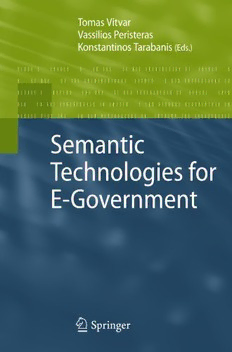
Semantic technologies for e-government PDF
Preview Semantic technologies for e-government
Semantic Technologies for E-Government Tomas Vitvar Vassilios Peristeras l l Konstantinos Tarabanis Editors Semantic Technologies for E-Government Editors TomasVitvar KonstantinosTarabanis Universita¨tInnsbruck UniversityofMacedonia InstituteofComputerScience InformationSystemsLab. ICT-Technologiepark EgnatiaStreet156 Technikerstr.21a 54006Thessaloniki 6020Innsbruck Greece Austria [email protected] [email protected] VassiliosPeristeras NationalUniversityofIreland,Galway DigitalEnterpriseResearchInstitute(DERI) IDABusinessPark,LowerDangan UniversityRoad,Galway Ireland [email protected] ACMComputingClassification(1998):J.1,H.3.5,H.4,I.2 ISBN:978-3-642-03506-7 e-ISBN:978-3-642-03507-4 DOI10.1007/978-3-642-03507-4 SpringerHeidelbergDordrechtLondonNewYork LibraryofCongressControlNumber:2009932128 #Springer-VerlagBerlinHeidelberg2010 Thisworkissubjecttocopyright.Allrightsarereserved,whetherthewholeorpartofthematerialis concerned,specificallytherightsoftranslation,reprinting,reuseofillustrations,recitation,broadcasting, reproductiononmicrofilmorinanyotherway,andstorageindatabanks.Duplicationofthispublication orpartsthereofispermittedonlyundertheprovisionsoftheGermanCopyrightLawofSeptember9, 1965,initscurrentversion,andpermissionforusemustalwaysbeobtainedfromSpringer.Violations areliabletoprosecutionundertheGermanCopyrightLaw. Theuseofgeneraldescriptivenames,registerednames,trademarks,etc.inthispublicationdoesnot imply,evenintheabsenceofaspecificstatement,thatsuchnamesareexemptfromtherelevantprotec- tivelawsandregulationsandthereforefreeforgeneraluse. Coverdesign:KuenkelLopkaGmbH,Heidelberg Printedonacid-freepaper SpringerispartofSpringerScience+BusinessMedia(www.springer.com) This book is dedicated to our children Kla´ra, Toma´sˇ, Vassiliki-Emmanouela, Constantine & Athanasios Foreword TheEuropeanUnionisuniqueinitsdiversity.Thisencompassesdifferenttechnical architectures,differentsortsoforganizations,differentlanguages,differentwaysof seeingthings,differentwaysoffindingsolutions,etc.Thisdiversitycansometimes be difficult to work with when in government or administration, but it is also an incrediblesource ofwealth. Itallows ustoseethingsthatwenormallywouldnot see and to do things that we normally would not do. We must therefore learn to exploitourdiversitytoourmutualbenefit. Semantic technology is an important contribution to that achievement. In my ownarea,ICTforgovernmentsandpublicservices,semantictechnologyholdsthe promise of a better governance system that works across national borders and institutionalboundaries,tothebenefitofallEuropeancitizens.Under the6thIST Research Framework Programme, the Commission DG Information Society and Media has supported research into the development of semantic technologies for publicadministrations–andthesupportedprojectsaredocumentedinthisbook. Thisbookisasignificanttestimonyofprogressintheareaofsemantictechno- logies for public administrations and also shows the European Commission’s continued support to research that combines societal aspects and scientific excel- lenceforthebenefitofallEuropeanCitizens. MechthildRohen HeadofUnitforICTforGovernmentsandPublicService vii Acknowlegements There were many contributors to the editing, writing, and reviewing of this book. First, we thank all the authors for their contributions as well as their attitude in providingtheeditorswithtimelyupdatesandresponsestoeditingrequests.Special thanks go to all people who helped with the review process that significantly contributed to the quality of the book: Michele Missikof, Tania Di Mascio, Marco Luca Sbodio, Ralf Klischewski, Ljiljana Stojanovic, Maciej Zaremba, Tomas Sabol, Karol Furdik, Luis A´lvarez Sabucedo, and Efthimios Tambouris. We thank to Jana Viskova for her contributions to chapter 1. We also thank Ralf Gerstner from Springer Germany for his great attitude and support for this book projectduringtheeditingandproductionprocess. Last butnotleast, we gratefully acknowledge the support,encouragement, and patienceofourwives. ix Contents Semantic Technologies for E-Government: An Overview .................... 1 Toma´sˇ Vitvar, Vassilios Peristeras, and Konstantinos Tarabanis Part I Architectures and Process Integration Pan-European E-Government Services Architecture ........................ 25 Toma´sˇ Vitvar, Adrian Mocan, Sanaullah Nazir, and Xia Wang Employing Semantic Technologies for the Orchestration of Government Services ...................................................... 47 Toma´sˇ Sabol, Karol Furdı´k, and Maria´n Mach The Modelling of Knowledge-Intensive Processes Using Semantics .................................................................... 75 Daniela Feldkamp, Knut Hinkelmann, and Barbara Tho¨nssen E-Government Goes Semantic Web: How Administrations Can Transform Their Information Processes ............................... 99 Ralf Klischewski and Stefan Ukena Part II Ontologies and Interoperability A Semantic Cooperation and Interoperability Platform for the European Chambers of Commerce ................................. 129 Michele Missikoff and Francesco Taglino SEEMP: A Networked Marketplace for Employment Services ........... 151 Irene Celino, Dario Cerizza, Mirko Cesarini, Emanuele Della Valle, Flavio DePaoli, Jacky Estublier, MariaGrazia Fugini, Asuncion Go´mez Pe´rez, Mick Kerrigan, Pascal Guarrera, Mario Mezzanzanica, Jaime Ramı`rez, Boris Villazon, and Gang Zhao xi xii Contents Semantic Repositories for eGovernment Initiatives: Integrating Knowledge and Services .................................................... 185 Matteo Palmonari and Gianluigi Viscusi Toward an E-Government Semantic Platform ............................. 209 Marco Luca Sbodio, Claude Moulin, Norbert Benamou, and Jean-Paul Barthe`s Part III Portals and User Interaction Semantic-Based Knowledge Management in E-Government: Modeling Attention for Proactive Information Delivery ................... 237 Konstantinos Samiotis and Nenad Stojanovic Personalization in E-Government: An Approach that Combines Semantics and Web 2.0 ..................................................... 261 Kay-Uwe Schmidt, Ljiljana Stojanovic, Nenad Stojanovic, and Susan Thomas A Semantically Enabled Portal for Facilitating the Public Service Provision ........................................................... 287 Nikolaos Loutas, Lemonia Giantsiou, Vassilios Peristeras, and Konstantinos Tarabanis Index ....................................................................... 315 Contributors Jean-PaulBarthe`s CNRSHeudiasyc,UMR6599,Universite´ deTechnologie de Compie`gne, Centre de Recherches de Royallieu, BP 20529, 60205 COMPIEGNE cedex, France Norbert Benamou Business Flow Consulting, 196 rue Houdan, F-92330 Sceaux, France IreneCelino CEFRIEL–PolitecnicoofMilano,ViaFucini2,20133Milano, Italy Dario Cerizza CEFRIEL – Politecnico of Milano, Via Fucini 2, 20133 Milano, Italy Mirko Cesarini Universita` di Milano-Bicocca, Via dell’Innovazione, 20100 Milano, Italy Flavio De Paoli Universita` di Milano-Bicocca, Via dell’Innovazione, 20100 Milano, Italy Emanuele Della Valle CEFRIEL – Politecnico of Milano, Via Fucini 2, 20133 Milano, Italy Jacky Estublier Equipe Adele, LSR, Universite´ Joseph Fourier, F-38041 Grenoble Cedex 9, France Daniela Feldkamp School of Business, University of Applied Sciences Northwestern Switzerland FHNW, Riggenbachstrasse 16, 4600 Olten, Switzerland MariaGraziaFugini CEFRIEL–PolitecnicoofMilano,ViaFucini2,20133 Milano, Italy xiii
